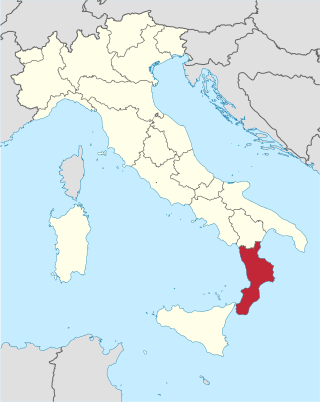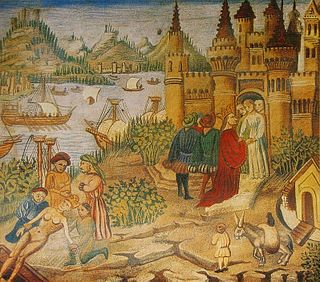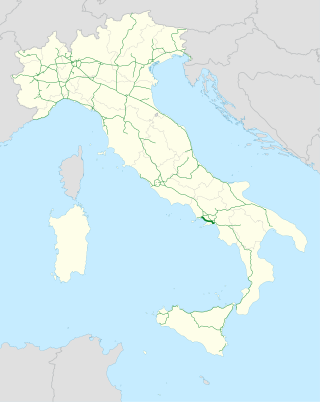Related Research Articles

Calabria is a region in Southern Italy. It is a peninsula bordered by Basilicata to the north, the Ionian Sea to the east, the Strait of Messina to the southwest, which separates it from Sicily, and the Tyrrhenian Sea to the west. It has almost 2 million residents across a total area of 15,222 km2 (5,877 sq mi). Catanzaro is the region's capital.

Salerno is an ancient city and comune (municipality) in Campania, southwestern Italy, and is the capital of the namesake province, being the second largest city in the region by number of inhabitants, after Naples. It is located on the Gulf of Salerno on the Tyrrhenian Sea. In recent history the city hosted Victor Emmanuel III, the King of Italy, who moved from Rome in 1943 after Italy negotiated a peace with the Allies in World War II, making Salerno the capital of the "Government of the South" and therefore provisional government seat for six months. Some of the Allied landings during Operation Avalanche occurred near Salerno.

Robert Guiscard, also referred to as Robert de Hauteville, was a Norman adventurer remembered for his conquest of southern Italy and Sicily in the 11th century.
Alexander Neckam was an English poet, theologian, and writer. He was an abbot of Cirencester Abbey from 1213 until his death.

The Schola Medica Salernitana was a medieval medical school, the first and most important of its kind. Situated on the Tyrrhenian Sea in the south Italian city of Salerno, it was founded in the 9th century and rose to prominence in the 10th century, becoming the most important source of medical knowledge in Western Europe at the time.

The Autostrada A3 is an autostrada 53.6 kilometres (33.3 mi) long in Italy located in the region of Campania, which runs from Naples to Salerno. It is a part of the E45 European route.
Rogerius, also called Rogerius Salernitanus, Roger Frugard, Roger Frugardi, Roggerio Frugardo, Rüdiger Frutgard and Roggerio dei Frugardi, was a Salernitan surgeon who wrote a work on medicine entitled Practica Chirurgiae around 1180. It is also called Chirurgiae Magistri Rogerii.
Romuald Guarna was the Archbishop of Salerno from 1153 to his death. He is remembered primarily for his Chronicon sive Annales, an important historical record of his time.
Conrad Dasypodius was a Swiss astronomer, mathematician, and writer. He was a professor of mathematics in Strasbourg, Alsace. He was born in Frauenfeld, Thurgau, Switzerland. His first name was also rendered as Konrad or Conradus or Cunradus, and his last name has been alternatively stated as Rauchfuss, Rauchfuß, and Hasenfratz. He was the son of Petrus Dasypodius, a humanist and lexicographer.

The Principality of Salerno was a medieval Southern Italian state, formed in 851 out of the Principality of Benevento after a decade-long civil war. It was centred on the port city of Salerno. Although it owed allegiance at its foundation to the Carolingian emperor, it was de facto independent throughout its history and alternated its allegiance between the Carolingians and their successors in the West and the Byzantine emperors in the east.

Celle di Bulgheria, also shortened as Celle, is a town and comune in the province of Salerno in the Campania region of south-western Italy.

The Archdiocese of Salerno-Campagna-Acerno is a Latin Church diocese of the Catholic Church in Campania, southern Italy, created in 1986. The historic Archdiocese of Salerno was in existence from the tenth century, having been elevated from a sixth-century diocese. The Diocese of Acerno was combined with the archdiocese in 1818.

Salerno railway station serves the Italian city of Salerno and was opened in 1866. It is the main railway station of the city.

The County of Apulia and Calabria, later the Duchy of Apulia and Calabria, was a Norman state founded by William of Hauteville in 1043, composed of the territories of Gargano, Capitanata, Apulia, Vulture, and most of Campania. It became a duchy when Robert Guiscard was raised to the rank of duke by Pope Nicholas II in 1059.
Szuper Beton was a UCI Continental cycling team, registered in Hungary. The team was founded in 2010 as De Rosa–Stac Plastic after the disappearance of LPR Brakes–Farnese Vini. The team held UCI Professional Continental status from 2010 to 2012, before dropping down to Continental in 2013. The team then downgraded to amateur status for its final two years of existence in 2016 and 2017.

Lucania was a Byzantine province (theme) in southern Italy that was probably established c. 968, under Emperor Nikephoros II Phokas.

The Salerno–Reggio Calabria railway is the most important north–south railway connection between Sicily, Calabria and the rest of the Italian peninsula. It forms the southern section of Corridor 1 of the European Union's Trans-European high-speed rail network, which connects Berlin and Palermo. Its southern part, between Rosarno and San Lucido is also used as an RFI freight route between the Port of Gioia Tauro and the Adriatic railway.

Trota of Salerno was a medical practitioner and writer in the southern Italian coastal town of Salerno who lived in the early or middle decades of the 12th century. She was one of a group of women physicians who studied in medieval Italy, at the Schola Medica Salernitana, the first medical schools to allow women in Europe.
Era mio Fratello is a two episode television miniseries that aired in 2007 on Rai Uno. The first episode aired on 30 September 2007 in Italy and the second episode aired on 1 October that same year. It is the first Italian television series having 'ndrangheta as main theme. Filming took place in Calabria, in the cities of Reggio Calabria, Palmi, Catona, Melito and Pentedattilo. The La Repubblica television critic Antonio Dipollina appreciated the miniseries, commenting that it has "the same rhythm and language of the most modern crime series".

The women of Salerno, also referred to as the ladies of Salerno and the Salernitan women, were a group of women physicians who studied in medieval Italy, at the Schola Medica Salernitana, one of the first medical schools to allow women.
References
- Wolfgang Stürner, Urso von Salerno, De commixtionibus elementorum libellus (1976)